
1 EN Instruction Manual DC Power Supply
1606-XLP15
1606-XLP30
2 DE Bedienungsanleitung DC Stromversorgung
3 FR Manual d'instructions DC Alimentation d'Énergie
4 ES Manual de instrucciones DC Fuente De Alimentación
5 IT Manuale di Istruzione DC Gruppo di alimentazione
6 PT Manual de Instruções DC Fonte De Alimentação
Read this first! English 1
Before operating this unit please read this manual thoroughly and retain this manual for future reference! This device may only be installed and put into operation by qualified personnel. If damage or
malfunction should occur during operation, immediately turn power off and send unit to the factory for inspection. The unit does not contain serviceable parts. The tripping of an internal fuse (if
included) is caused by an internal defect. The information presented in this document is believed to be accurate and reliable and may change without notice. For any clarifications the English
translation will be used.
Intended Use: This power supply is designed for installation in an enclosure and is intended for general use such as in industrial control, office, communication, and instrumentation equipment. Do
not use this power supply in aircraft, trains and nuclear equipment where malfunction may cause severe personal injury or threaten human life.
WARNING
CAUTION
Risk of electrical shock, fire, personal injury or death.
1) Do not use the power supply without proper grounding (Protective Earth).
2) Turn power off before working on the device. Protect against inadvertent re-powering.
3) Make sure that the wiring is correct by following all local and national codes.
4) Do not modify or repair the unit.
5) Do not open the unit as high voltages are present inside.
6) Use caution to prevent any foreign objects from entering the housing.
7) Do not use in wet locations or in areas where moisture or condensation can be expected.
8) Do not touch during power-on, and immediately after power-off. Hot surfaces may cause burns.
Reduction of output current may be necessary when:
1) Minimum installation clearance can not be met.
2) Altitude is higher than 2000m.
3) Device is used above +60°C ambient.
4) Mounting orientation is other than input terminal located at the bottom and
output at the top.
5) Airflow for convection cooling is obstructed.
Details for de-rating can be found in this manual and in the datasheet of the unit..
WARNING EXPLOSION HAZARDS (Notes for use in hazardous locations only)
Units which are marked with "Class I Div 2" are suitable for use in non-hazardous or Class I Division 2 Groups A, B, C, D locations only.
Substitution of components may impair suitability for Class I Division 2 environment. Do not disconnect equipment unless power has been switched off.
Wiring must be in accordance with Class I, Division 2 wiring methods of the National Electrical Code, NFPA 70, and in accordance with other local or national codes.
Vor Inbetriebnahme lesen! Deutsch 2
Bitte lesen Sie diese Warnungen und Hinweise sorgfältig durch, bevor Sie das Gerät in Betrieb nehmen. Bewahren Sie die Anleitung zum Nachlesen auf. Das Gerät darf nur durch fachkundiges und
qualifiziertes Personal installiert werden. Bei Funktionsstörungen oder Beschädigungen schalten Sie sofort die Versorgungsspannung ab und senden das Gerät zur Überprüfung ins Werk. Das Gerät
beinhaltet keine Servicebauteile. Interne Sicherungen (falls vorhanden) lösen nur bei Gerätedefekt aus. Die angegebenen Daten dienen allein der Produktbeschreibung und sind nicht als
zugesicherte Eigenschaften im Rechtssinne aufzufassen. Im Zweifelsfall gilt der englische Text.
Bestimmungsgemäßer Gebrauch: Diese Stromversorgung ist für den Einbau in ein Gehäuse konzipiert und zur Verwendung für allgemeine elektronische Geräte, wie z.B. Industriesteuerungen,
Bürogeräte, Kommunikationsgeräte oder Messgeräte geeignet. Benutzen Sie diese Stromversorgung nicht in Steuerungsanlagen von Flugzeugen, Zügen oder nuklearen Einrichtungen, in denen eine
Funktionsstörung zu schweren Verletzungen führen oder Lebensgefahr bedeuten kann.
WARNUNG
VORSICHT
Missachtung nachfolgender Punkte kann einen elektrischen Schlag, Brände, schwere Unfälle oder Tod zur Folge
haben.
1) Betreiben Sie die Stromversorgung nie ohne Schutzleiter.
2) Schalten Sie die Eingangsspannung vor Installations-, Wartungs- oder Änderungsarbeiten ab und sichern Sie
diese gegen unbeabsichtigtes Wiedereinschalten.
3) Sorgen Sie für eine ordnungsgemäße und fachgerechte Verdrahtung.
4) Führen Sie keine Änderungen oder Reparaturversuche am Gerät durch.
5) Gerät niemals öffnen. Im Inneren befinden sich gefährliche Spannungen.
6) Verhindern Sie das Eindringen von Fremdkörpern, wie z.B. Büroklammern und Metallteilen.
7) Betreiben Sie das Gerät nicht in feuchter Umgebung oder in einer Umgebung mit Betauung
8) Gehäuse nicht während des Betriebes oder kurz nach dem Abschalten berühren. Heiße Oberflächen können
Verletzungen verursachen.
Rücknahme der Ausgangsleistung kann erforderlich sein:
1) wenn die minimalen Einbauabstände nicht eingehalten werden können.
2) bei Aufstellhöhen über 2000m.
3) Betrieb bei Umgebungstemperaturen über +60°C.
4) bei Einbaulagen abweichend von der Standardeinbaulage (Eingang unten,
Ausgang oben).
5) bei behinderter Luftzirkulation.
Details zur Leistungsrücknahme befinden sich in dieser Betriebsanleitung oder im
Datenblatt des Gerätes.
ACHTUNG EXPLOSIONSGEFAHR! (Hinweise für den Betrieb in explosionsgefährdeter Umgebung)
Geräte, die am Leistungsschild mit "Class I Div 2" gekennzeichnet sind, sind für den Einsatz in Klasse I Division 2 Gruppen A,B,C,D oder für nicht explosionsgefährdete Aufstellorte geeignet.
Veränderungen an Bauteilen können die Tauglichkeit für Klasse I Division 2 beeinträchtigen. Anschlüsse nicht trennen, solange Spannung anliegt. Anschluss muss unter Berücksichtigung der
Anforderungen nach Klasse I Division 2 Artikel 501-4(b) des National Electrical Code, NFPA 70, erfolgen.
A lire avant mise sous tension! Français 3
Merci de lire ces instructions de montage et d'entretien avant de mettre l'alimentation sous tension. Conservez ce manuel qui vous sera toujours utile. Cette alimentation doit être installée par du
personnel qualifié et compétent. Le déclenchement du fusible interne traduit très probablement un défaut au niveau de l'appareil. Si un défaut quelconque apparaît en cours de fonctionnement,
débrancher au plus vite l'alimentation. Dans ce deux cas de figure, il convient de faire contrôler l'alimentation en usine! Les données indiquées dans ce document servent uniquement à donner une
description du produit et n'ont aucune valeur juridique. En cas de divergences, le texte anglais fait foi.
Utilisation: Cet appareil est conçu pour être installé dans une armoire et pour tous les équipements électroniques, tel que l'équipement industriel de commande, l'équipement de bureau, le matériel
de communication et les instruments de mesures. N'utilisez pas cet appareil pour l'équipement de commandes dans les avions, les trains et l'équipement atomique où un problème de
fonctionnement de l'alimentation pourrait causer des blessures graves ou menacer la vie humaine.
AVERTISSEMENT
ATTENTION
Prendre en compte les points suivants, afin d'éviter toute détérioration électrique, incendie, dommage aux
personnes ou mort.
1) ne jamais faire fonctionner l'alimentation sans raccordement à la terre !
2) débrancher l'installation avant toute intervention sur l'alimentation (ou démontage) et s'assurer qu'il n'y a pas
risque de redémarrage.
3) s'assurer que le câblage a été fait selon les prescriptions
4) ne pas effectuer de réparations ou modifications sur l'alimentation
5) ne pas ouvrir l'appareil. Des tensions importantes passent à l'intérieur.
6) veiller à ce qu'aucun objet ne rentre en contact avec l'intérieur de l'alimentation (trombones, pièces
métalliques)
7) ne pas faire fonctionner l'appareil dans un environnement humide ou à l'extérieur, non protégé. Ne pas utiliser
l'appareil dans un environnement où il peut y avoir de la condensation.
8) ne pas toucher le carter pendant le fonctionnement ou après la mise sous tension. Surface chaude risquant
d’entraîner des blessures.
Des limitations de puissance de sortie peuvent apparaître si :
1) les distances d'installation mini. ne peuvent être observées
2) installation à une altitude > 2000 m
3) pour des fonctionnements en charge et avec une température ambiante > 60°C
4) pour des positions de montage différentes de la préconisation standard (entrée
dessous, sortie en haut).
5) lorsque la circulation d'air est gênée
D'autres informations sont disponibles dans la documentation de mise en service
ATTENTION RISQUE D’ EXPLOSION (Utilisation Class I Div 2) Les appareils portant la marque ‘Class I Div 2’ au niveau de la plaque signalétique sont prévus pour fonctionner en Classe I, Division
2, Groupes A,B,C,D ou pour un environnement non explosif et non dangereux. Le remplacement de composants peut rendre le matériel impropre à une utilisation en Classe 1, Division 2. Ne
déconnecter l’équipement qu’ hors tension ou en zone connue comme non dangereuse. Le raccordement doit obligatoirement tenir compte des exigences de la classe 1, division 2, article 501-4(b)
du National Electrical Code, NFPA 70.

Lea primero! Español 4
Conserve este manual como referencia para futuras consultas. La fuente de alimentación solo puede ser instalada y puesta en funcionamiento por personal cualificado. Por favor lea detenidamente
este manual antes de conectar la fuente de alimentación. Cuando se funde un fusible interno, existe gran probabilidad de un fallo interno en el equipo.Si se produce un fallo o mal funcionamiento
durante la operación, desconecte inmediatamente la tensión de alimentación. En ambos casos, el equipo debe ser inspeccionado en fábrica. La información presentada en este documento es
exacta y fiable en cuanto a la descripción del producto y puede cambiar sin aviso. En casa de duda, prevalece el texto inglés.
Uso apropiado: Este equipo ha sido diseñado para su instalación en un ambiente cerrado y ha sido concebido para uso general en instalaciones de control industrial, oficinas, comunicaciones y
equipos de instrumentación. No emplee este equipo en aeronaves, trenes e instalaciones atómicas, donde un mal funcionamiento de la fuente de alimentación puede ocasionar lesiones graves o
riesgo mortal.
ADVERTENCIA
ATENCIÓN
Riesgo de descarga eléctrica, incendio, accidente grave o muerte.
1) No conectar nunca la unidad sin conexión de puesta a tierra.
2) Desconectar la tensión de red antes de trabajar en la fuente de alimentación. Evite una posible reconexión
involuntaria.
3) Asegurarse de que el cableado es correcto de acuerdo a los códigos locales y nacionales.
4) No realizar ninguna modificación o reparación de la unidad.
5) No abrir nunca la unidad. En el interior existe riesgo de altas tensiones.
6) Evitar la introducción en la carcasa de objetos extraños.
7) No usar el equipo en ambientes húmedos. No operar el equipo en ambientes donde se espere la formación
de rocío o condensación.
8) No tocar durante el funcionamiento ni inmediatamente después del apagado. El calor de la superficie puede
causar quemaduras graves
La deriva en la tensión de salida se produce:
1) cuando no pueden mantenerse las distancias mínimas de montaje.
2) en caso de que el montaje se realice en altitudes superiores a los 2000 m.
3) en caso de funcionamiento a plena carga y temperaturas ambientales
superiores a +60ºC.
4) en caso de posiciones de montaje diferentes a la posición de montaje
estándar (terminales de entrada abajo y terminales de salida arriba).
5) en caso de que la circulación de aire para la refrigeración por conducción esté
obstruida.
Puede encontrar más detalles del caso de deriva en este manual.
ATENCIÓN PELIGRO DE EXPLOSIÓN! (Uso apropiado Class I Div 2) Los equipos marcados con la expresión "Class I Div 2" son adecuados para su uso en ambientes no peligrosos y en entornos
con la Clase I División 2 Grupos A, B, C, D. La sustitución de componentes puede perjudicar la idoneidad para la Clase I División 2. No desconecte el equipo a menos que la tensión de alimentación
esté desconectada. El conexionado debe cumplir con la Clase I División 2 métodos de conexión del Código Nacional Eléctrico NFPA 70 o con el resto de códigos locales o nacionales.
Leggere prima questa parte! Italiano 5
Prima di collegare il sistema di alimentazione elettrica si prega di leggere attentamente le seguenti avvertenze. Conservare le istruzioni per la consultazione futura. Il sistema di alimentazione elettrica
deve essere installato solo da personale competente e qualificato. In caso di intervento del fusibile interno, molto probabilmente l'apparecchio è guasto. Se durante il funzionamento si verificano
anomalie o guasti, scollegare immediatamente la tensione di alimentazione. In entrambi i casi è necessario far controllare l'apparecchio dal produttore! I dati sono indicati solo a scopo descrittivo del
prodotto e non vanno considerati come caratteristiche garantite dell'apparecchio.In caso di differenze o problemi è valido il testo inglese
Uso previsto: Questo apparecchio è previsto per il montaggio in un rack per moduli elettronici, ad esempio per controllori industriali, apparecchiature per ufficio, unità di comunicazione o apparecchi
di misura. Non utilizzare l'apparecchio in impianti di controllo di aerei, di treni o di impianti nucleari in cui il suo eventuale guasto può comportare gravi lesioni o la morte di persone.
AVVERTENZA
ATTENZIONE
Il mancato rispetto delle seguenti norme può provocare folgorazione elettrica, incendi, gravi incidenti e perfino la
morte.
1) Non far funzionare in nessun caso il sistema di alimentazione elettrica senza conduttore di protezione!
2) Prima di eseguire interventi di installazione, di manutenzione o di modifica scollegare la tensione di rete ed
adottare tutti i provvedimenti necessari per impedirne il ricollegamento non intenzionale.
3) Assicurare un cablaggio regolare e corretto.
4) Non tentare di modificare o di riparare da soli l'apparecchio.
5) Non aprire l'apparecchio. Al suo interno sono applicate tensioni elettriche pericolose.
6) Impedire la penetrazione di corpi estranei nell'apparecchio, ad esempio fermagli o altri oggetti metallici.
7) Non far funzionare l'apparecchio in un ambiente umido. Non far funzionare l'apparecchio in un ambiente
soggetto alla formazione di condensa o di rugiada.
8) Non toccare quando acceso e subito dopo lo spegnimento. La superficie calda può causare scottature.
È necessario ridurre la potenza di uscita se:
1) non è possibile rispettare le distanze minime di montaggio;
2) l'apparecchio viene installato in un luogo di altitudine maggiore di 2000 m;
3) il funzionamento è a pieno carico a temperatura ambiente maggiore di +60°C;
4) la posizione di montaggio differisce da quella standard (ingresso in basso,
uscita in alto).
5) è ostacolata la libera circolazione dell'aria.
Ulteriori informazioni sono riportate in questo manuale.
ATTENZIONE: PERICOLO DI ESPLOSIONE! (Uso previsto Class I Div 2)
Gli apparecchi la cui targhetta riporta "Class I Div 2" sono adatti per l'impiego in ambienti di classe I, divisione 2, gruppi A, B, C e D o non soggetti al pericolo di esplosione. La modifica dei
componenti possono influenzare negativamente l'idoneità per ambienti di classe I, divisione 2.Non aprire i morsetti con tensione di alimentazione collegata. Il collegamento deve essere eseguito nel
rispetto dei requisiti previsti dalla classe I, divisione 2, articolo 501-4(b) del National Electrical Code, NFPA 70.
Leia primeiro! Portuguès 6
Recomendamos a leitura cuidadosa das seguintes advertências e observações, antes de colocar em funcionamento a fonte de alimentação. Guarde as Instruções para futura consulta, em casos de
dúvida. A fonte de alimentação deverá ser instalada apenas por profissionais da área, tecnicamente qualificados. Se o fusível interno se fundir, é grande a possibilidade de existir um defeito no
aparelho. Se por acaso, durante a utilização ocorrer algum defeito de funcionamento ou dano, desligue imediatamente a tensão de alimentação. Em ambos os casos, será necessária uma
verificação na Fábrica! Os dados mencionados têm como finalidade somente a descrição do produto, e não devem ser interpretados como propriedades garantidas no sentido jurídico. Em caso de
duvidas aplica-se o texto em inglês.
Utilize: Apenas para o fim pré-estabelecido. Este aparelho foi concebido para ser montado dentro de invólucros, caixas ou armários para aparelhos eletrônicos em geral, como, por exemplo,
comandos de instalações industriais, aparelhos para escritórios, aparelhos de comunicação ou instrumentos de medida e quadros eléctricos. Não utilize este aparelho em sistemas de comando de
aviões, de comboios ou em instalações movidas por energia nuclear, nos quais um defeito de funcionamento poderá causar danos graves ou significar risco de morte.
ATENÇÃO
CUIDADO
A não observância ou o incumprimento dos pontos a seguir mencionados, poderá causar uma descarga elétrica,
incêndios, acidentes graves ou morte.
1) Não use a fonte de alimentação sem o condutor de proteção terra!
2) Antes de trabalhos de instalação, manutenção ou modificação, desligue a tensão de alimentação,
protegendo-a contra uma nova ligação involuntária.
3) As ligações devem ser efectuadas apenas por profissionais competentes.
4) Não efectue nenhuma modificação ou tentativa de reparação no aparelho. Quando necessário contacte o seu
distribuidor.
5) Não abra o aparelho mesmo quando desligado. No seu interior existem condensadores que podem estar
carregados electricamente.
6) Proteger a fonte de alimentação contra a introdução inadvertida de corpos metálicos, como por ex., clipes ou
outras peças de metal.
7) Não usar o aparelho em ambientes húmidos. Não usar o aparelho em ambientes propensos a condensações.
8) Não tocar enquanto estiver em funcionamento, nem após a desligar. A superficie poderá estar quente e
provocar lesões.
Será necessário reduzir a potência de saída nos seguintes casos:
1) Quando não forem observadas as distâncias mínimas de montagem.
2) Quando instaladas a altitudes superiores a 2000m.
3) Existencia de temperatura ambiente superior a +60ºC, em plena carga do
aparelho.
4) Montagem invertida do aparelho (Entrada em baixo, saída em cima).
5) Montagem em ambiente sem ventilação.
No presente manual de funcionamento encontram-se ainda outras informações.
ATENÇÃO, RISCO DE EXPLOSÃO! (Utilize Class I Div2)
Aparelhos que contêm na sua placa de dados elétricos o texto “Class I Div 2” são apropriados para a aplicação na Classe I, divisão 2, Grupos A, B, C, D ou também para locais de instalação isentos
de riscos de explosão. Modificações efetuadas em componentes podem restringir ou reduzir a adequação para aplicação na Classe I, Divisão 2. As ligações não devem ser separadas enquanto
estiverem ligadas a uma fonte de alimentação elétrica. As ligações devem ser efetuadas levando-se em consideração as exigências normativas da Classe I, Divisão 2.
Rockwell Automation
CH-5001 Aarau, Switzerland
Fax +41 62 837 2202
© 2011 by
Allen-Bradley Company, LCC
Industrial Components Business
1201 South Second Street
Milwaukee, WI 53204-2496 USA
Phone 440 646 5800

1606-XLP15 Series, 1606-XLP30 Power Supply Instruction Manual
1606-XLP15 Serie, 1606-XLP30 Bedienungsanleitung für Stromversorgung
Technical Data
1)
Technische Daten
1)
1606-XLP15A 1606-XLP15B 1606-XLP15E 1606-XLP30EQ
Output Voltage Ausgangsspannung nom. DC 5-5.5V DC 12-15V DC 24-28V DC 24-28V
Factory Setting at Full Load Werkseinstellung bei Nennlast “Single-Use”, typ. 5.1V 12.0V 24.5V 24.5V
Output Current Ausgangsstrom nom. 3A at 5V
2.72A at 5.5V
1.3A at 12V
1.0A at 15V
0.63A at 24V
0.54A at 28V
1.3A at 24V
1.1A at 28V
Output Power Ausgangsleistung nom. 15W 15W 15W 30W
Output Ripple & Noise Voltage
2)
Ausgangswelligkeit
2
) max. 50mVpp 75mVpp 50mVpp 50mVpp
AC Input Voltage AC Eingangsspannung nom. AC 100-240V
-15%/+10%
AC 100-240V
-15%/+10%
AC 100-240V
-15%/+10%
AC 100-240V
-15%/+10%
Input Frequency Eingangsfrequenz nom. 50-60Hz 50-60Hz 50-60Hz 50-60Hz
AC Input Current
3)
AC Eingangsstrom
3)
typ. 0.28A / 0.17A 0.28A / 0.17A 0.28A / 0.17A 0.54A / 0.3A
Power Factor
3)
Leistungsfaktor
3)
typ. 0.51 / 0.44 0.51 / 0.44 0.51 / 0.44 0.52 / 0.49
Allowed Voltage L or N to Earth Erlaubte Spannung L oder N zu Erde max. 264Vac / 375Vdc 264Vac / 375Vdc 264Vac / 375Vdc 264Vac / 375Vdc
Input Inrush Current
4)
Einschaltspitzenstrom
4)
typ. 16A / 31A 16A / 31A 16A / 31A 18A / 35A
Hold-up Time
3)
Pufferzeit
3)
typ. 45ms / 186ms 46ms / 191ms 47ms / 196ms 31ms / 141ms
Efficiency
3)
Wirkungsgrad
3)
typ. 76.8% / 77.2% 83.0% / 82.5% 86.1% / 85.1% 88.5% / 89.4%
Power Losses
3)
Verlustleistung
3)
typ. 4.6W / 4.5W 3.2W / 3.1W 2.5W / 2.7W 4.1W / 3.7W
Operational Temperature Range Betriebstemperaturbereich nom. -10°C - +70°C -10°C - +70°C -10°C - +70°C -10°C - +70°C
Output Derating Leistungsrücknahme +60°C to +70°C 0.4W/°C 0.4W/°C 0.4W/°C 0.8W/°C
Storage Temperature Range Lagertemperaturbereich nom. -40°C - +85°C -40°C - +85°C -40°C - +85°C -40°C - +85°C
Humidity
5)
Feuchte
5)
IEC 60068-2-30 5 - 95% r.H. 5 - 95% r.H. 5 - 95% r.H. 5 - 95% r.H.
Vibration Schwingen IEC 60068-2-6 2g 2g 2g 2g
Shock Schocken IEC 60068-2-27 30g 6ms, 20g 11ms 30g 6ms, 20g 11ms 30g 6ms, 20g 11ms 30g 6ms, 20g 11ms
Degree of Pollution (non-conductive) Verschmutzungsgrad (nicht leitend) EN 50178,
IEC 62103
22 22
Degree of Protection Schutzart EN 60529 IP20 IP20 IP20 IP20
Class of Protection Schutzklasse IEC 61140 I
6)
I
6)
I
6)
I
6)
Over-temperature Protection Übertemperaturschutz OTP No / Nein No / Nein No / Nein No / Nein
Output Over-voltage Protection Überspannungsschutz am Ausgang OVP, max. 9.6Vdc 25Vdc 37Vdc 37Vdc
Leakage Current
7)
TN/TT-mains PE- Ableitstrom
7)
TN/TT- Netze max. 0.3mA / 0.54mA 0.3mA / 0.54mA 0.3mA / 0.54mA 0.3mA / 0.54mA
IT-mains IT- Netze 0.66mA / 1.08mA 0.66mA / 1.08mA 0.66mA / 1.08mA 0.66mA / 1.08mA
Return Voltage Resistance
8)
Rückspeisefestigkeit
8)
max. 6.3Vdc 25Vdc 35Vdc 35Vdc
Parallel Use
11)
Parallelschaltbar
11)
- Yes / Ja Yes / Ja Yes / Ja Yes / Ja
Serial Use
12)
Serienschaltbar
12)
- Yes / Ja Yes / Ja Yes / Ja Yes / Ja
Dimensions
9)
(WxHxD) Abmessungen
9)
(BxHxT) nom. 22.5x75x91mm 22.5x75x91mm 22.5x75x91mm 22.5x75x91mm
Weight Gewicht max. 130g / 0.29lb 130g / 0.29lb 130g / 0.29lb 140g / 0.31lb
Approvals Zulassungen - 10) 10) 10) 10)
1) All parameters are specified at 230Vac input voltage, nominal output current, 25°C ambient
and after a 5 minutes run-in time unless otherwise noted.
2) 50-Ohm measurement, bandwidth 20MHz
3) at 120Vac, 60Hz / 230Vac 50Hz
4) Peak value at 120Vac / 230Vac, at an ambient temperature of 40°C and cold start.
5) Do not energize while condensation is present.
6) PE connection required (Ground).
7) Leakage current at 132Vac, 60Hz / 264Vac, 50Hz
8) Loads such as decelerating motors and inductors can feed voltage back to the output of the
power supply. The figure represents the maximum allowed feed back voltage
9) Depth without DIN-rail.
10) See datasheet or markings on the unit.
11) No current share between the units, ensure that ambient temperature stays below 45°C
12) Use only power supplies of the same type. The total output voltage should not be >150Vdc.
1) Alle Werte gelten bei 230Vac Eingangsspannung, Nennausgangsstrom, 25°C Umgebung und
nach einer Aufwärmzeit von 5 Minuten, wenn nichts anderes angegeben ist.
2) 50-Ohm Messung, Bandbreite 20MHz
3) bei 120Vac, 60Hz / 230Vac, 50Hz
4) Spitzenstrom bei 120Vac / 230Vac, einer Umgebungstemperatur von 40°C und Kaltstart.
5) Nicht betreiben, solange das Gerät Kondensation aufweist.
6) PE Verbindung erforderlich.
7) Ableitstrom bei 132Vac, 60Hz / 264Vac, 50Hz
8) Bremsende Motoren oder Induktivitäten können Spannung zum Ausgang des Netzteils
rückspeisen. Der Wert gibt die max. zulässige Rückspeisespannung an.
9) Tiefe ohne DIN-Schiene
10) Siehe Datenblatt oder Prüfzeichen auf dem Gerät.
11) Keine Stromaufteilung zwischen den Geräten. Maximale Umgebungstemperatur 45°C
12) Nur gleiche Geräte bis zu einer Gesamtspannung von 150Vdc
Installation
Use DIN-rails according to EN 60715 or EN 50022 with a height of 7.5 or 15mm. Mounting
orientation must be output terminals on top and input terminals on the bottom. For other
orientations see datasheet. Do not obstruct air flow as the unit is convection cooled. Ventilation
grid must be kept free of any obstructions. The following installation clearances must be kept
when power supplies are permanently fully loaded:
Left / right: 0mm (or 15mm in case the adjacent device is a heat source)
40mm on top, 20mm on the bottom of the unit.
Installation
Geeignet für DIN-Schienen entsprechend EN 60715 oder EN 50022 mit einer Höhe von 7,5 oder
15mm. Der Einbau hat so zu erfolgen, dass sich die Eingangsklemmen unten und die
A
usgangsklemmen oben befinden. Für andere Einbaulagen siehe Datenblatt. Luftzirkulation nicht
behindern! Das Gerät ist für Konvektionskühlung ausgelegt. Es ist für ungehinderte Luftzirkulation
zu sorgen. Folgende Einbauabstände sind bei dauerhafter Volllast einzuhalten:
Links / rechts: 0mm (oder 15mm bei benachbarten Wärmequellen)
Oben: 40mm, unten 20mm vom Gerät.
Input Fuses
Internal input fuse: T3.15A (H.B.C.), not user accessible. The unit is tested and approved for
branch circuits up to 20A. An external protection is only required if the supplying branch has an
ampacity greater than this, however, in some countries local regulations might apply. Check local
codes and requirements. If an external fuse is necessary or utilized, minimum requirements need
to be considered to avoid nuisance tripping of the circuit breaker. A minimum value of 10A B- or
6A C-Characteristic breaker should be used.
Sicherungen am Eingang
Das Gerät besitzt eine T3,15A (H.B.C.) Eingangssicherung, die nicht anwenderzugänglich ist. Das
Gerät ist geprüft und zugelassen zum Anschluss an Stromkreisen bis max. 20A. Ein zusätzlicher
externer Schutz ist nur erforderlich, wenn der Speisestromkreis mit einem höheren Wert
abgesichert ist oder nationale Richtlinien es vorschreiben. Falls ein externes Schutzelement
verwendet wird, soll dieses nicht kleiner als 10A B- oder 6A C-Charakteristik sein, um ein
fehlerhaftes Auslösen zu vermeiden.
Terminals and Wiring
Use appropriate copper cables that are designed for a minimum operating temperatures of 60°C
(for ambient up to 45°C) and 75°C (for ambient up to 60°C). Follow national installation codes and
regulations! Ensure that all strands of a stranded wire enter the terminal connection! Up to two
stranded wires with the same cross section are permitted in one connection point (except PE
wire). Ferrules are allowed, but not required.
Solid wire 0.5-6mm
2
Stranded wire 0.5-4mm
2
American wire gauge 20-10 AWG
Wire stripping length 7mm / 0.28inch
Tightening torque 1Nm / 9lb.inch
Anschlussklemmen und Verdrahtung
Verwenden Sie geeignete Kupferkabel, die mindestens für 60°C bei Umgebungstemperaturen bis
zu 45°C und 75°C bei einer Umgebungstemperatur bis zu 60°C zugelassen sind. Beachten Sie
nationale Bestimmungen und Installationsvorschriften! Stellen Sie sicher, dass keine einzelnen
Drähte von Litzen abstehen. Bis zu zwei Leiter mit gleichem Querschnitt sind in einem
A
nschlusspunkt zulässig (außer Schutzleiter). Aderendhülsen sind erlaubt, aber nicht erforderlich.
Starrdraht 0.5-6mm
2
Litze 0.5-4mm
2
AWG 20-10 AWG
Abisolierlänge 7mm / 0.28inch
Anzugsdrehmoment 1Nm / 9lb.inch

1606-XLP15 Series, 1606-XLP30 Power Supply Instruction Manual
1606-XLP15 Serie, 1606-XLP30 Bedienungsanleitung für Stromversorgung
EMC Electromagnetic Compatibility
These power supplies are suitable for applications in industrial environment as well as in
residential, commercial and light industry environment without any restrictions. These devices
comply with FCC Part 15 rules.
CE mark is in conformance with EMC directive 2004/108/EC as well as the low-voltage directive
(LVD) 2006/95/EC.
EMC Immunity: EN 61000-6-1, EN 61000-6-2
EMC Emission EN 61000-6-3, EN 61000-6-4, FCC Part 15 Class B
EMV Elektromagnetische Verträglichkeit
Diese Stromversorgungen erfüllen die Anforderungen für Anwendungen in industrieller Umgebung
und für den Wohn-, Geschäfts- und Gewerbebereich ohne Einschränkungen. Die Geräte erfüllen
auch die Anforderungen der FCC Teil 15.
Das CE Zeichen ist angebracht und erklärt die Erfüllung der EMV Richtlinie 2004/108/EG wie
auch der Niederspannungsrichtlinie 2006/95/EG.
Störfestigkeit: EN 61000-6-1, EN 61000-6-2
Störaussendung: EN 61000-6-3, EN 61000-6-4, FCC Part 15 Klasse B
Parallel-Use to Increase the Output Power
The power supplies can be paralleled to increase the output power. There is no feature included
which balances the load current between the power supplies. Usually the power supply with the
higher adjusted output voltage draws current until it goes into current limitation. This means no
harm to this power supply as long as the ambient temperature stays below 45°C. The output
voltages of all power supplies shall be adjusted to the same value (±100mV). A fuse or diode on
the output of each unit is only required if more than three units are connected in parallel. If a fuse
(or circuit breaker) is used, choose one with approximately 150% of the rated output current of
one power supply. Keep an installation clearance of 15mm (left / right) between two power
supplies and avoid installing the power supplies on top of each other. Do not use power supplies
in parallel in mounting orientations other than the standard mounting orientation (input terminals
on the bottom and output terminals on top of the unit). Pay attention that leakage current, EMI,
inrush current, harmonics will increase when using multiple power supplies.
Parallelbetrieb zur Leistungserhöhung
Die Stromversorgungen können zur Leistungserhöhung parallel geschaltet werden. Es bestehen
j
edoch keine Maßnahmen zur gleichmäßigen Stromverteilung zwischen den Geräten. Die
Stromversorgung mit der leicht höher eingestellten Ausgangsspannung liefert solange Strom bis
die Strombegrenzung eingreift und die Ausgangsspannung leicht absinken lässt. Solange die
Umgebungstemperatur unterhalb 45°C ist, besteht keine Gefahr für die Geräte. Die
A
usgangsspannung aller Geräte soll auf denselben Wert eingestellt sein (±100mV). Eine
Sicherung oder Diode am Ausgang ist erforderlich wenn mehr als 3 Geräte parallel geschaltet
werden (Sicherungswert mit etwa dem 1,5fachen des Nennstromes der Stromversorgung).
Zwischen den Geräten ist ein seitlicher Abstand von mindestens 15mm einzuhalten.
Stromversorgungen nicht übereinander anordnen und nur in der Standardeinbaulage verwenden
(Eingang unten und Ausgang oben). Bei der Verwendung von mehreren Stromversorgungen
erhöhen sich eingangsseitig der Ableitstrom, Oberwellenstrom, Einschaltspitzenstrom und die
EMV Werte und müssen gesondert beachtet werden.
Series-Operation
Power supplies of the exact same type can be connected in series for higher output voltages. It is
possible to connect as many units in series as needed, providing the sum of the output voltage
does not exceed 150Vdc. Voltages with a potential above 60Vdc are not SELV any more and can
be dangerous. Such voltages must be installed with a protection against touching. Earthing of the
output is required when the sum of the output voltage is above 60Vdc. Keep an installation
clearance of 15mm (left / right) between two power supplies and avoid installing the power
supplies on top of each other. Do not use power supplies in series in mounting orientations other
than the standard mounting orientation (input terminals on the bottom and output terminals on top
of the unit). Pay attention that leakage current, EMI, inrush current, harmonics will increase when
using multiple power supplies.
Betrieb in Serienschaltung
Stromversorgungen vom exakt gleichen Typ dürfen bis zu einer Gesamtspannung von 150Vdc in
Serie geschaltet werden. Spannungen über 60Vdc gelten nicht mehr als SELV und sind
berührgeschützt zu verlegen. Eine Erdung der Ausgangsspannung ist bei Spannungen über
60Vdc erforderlich.
Zwischen den Geräten ist ein seitlicher Abstand von mindestens 15mm einzuhalten.
Stromversorgungen nicht übereinander anordnen und nur in der Standardeinbaulage verwenden
(Eingang unten und Ausgang oben). Bei der Verwendung von mehreren Stromversorgungen
erhöhen sich eingangsseitig der Ableitstrom, Oberwellenstrom, Einschaltspitzenstrom und die
EMV Werte und müssen gesondert beachtet werden.
Output- and Overload Characteristic (see Fig. 1 to 4)
XLP15 Above the rated output current, the output voltage will decrease as a result of the output
current limitation. In case of excessive overloads, the unit will switch off and will make
automatically start-up attempts (Hiccup-Mode). Similar behavior can occur with loads
having large input capacitors included. See also datasheet for details.
XLP30 Above the rated output current, the output voltage will decrease as a result of the output
current limitation. The current flows continuously. No hiccup or shut-down behaviour.
Ausgangs- und Überlastverhalten (siehe Bild 1 bis 4)
XLP15 Wird der Nennausgangsstrom überschritten, sinkt die Ausgangsspannung als Folge der
strombegrenzenden Wirkung des Gerätes. Bei extremer Überlastung schaltet das Gerät ab
und macht automatische Startversuche (Hiccup-Mode). Ähnliches Verhalten kann auch bei
Lasten mit großen Eingangskapazitäten auftreten. Siehe auch Informationen im Datenblatt.
XLP30 Wird der Nennstrom überschritten, sinkt die Spannung aufgrund der Strombegrenzungs-
eigenschaft. Der Strom fließt ununterbrochen weiter, kein Hiccup oder Abschaltverhalten.
Dielectric Strength (see Fig. 5)
The output voltage is floating and separated from the input according to SELV (IEC/EN 60950-1)
and PELV (EN 60204-1, EN 50178; IEC 62103, IEC 60364-4-41) requirements. Type and factory
tests are conducted by the manufacturer. Field tests may be conducted in the field using the
appropriate test equipment which applies the voltage with a slow ramp (2s up and 2s down).
Connect all phase-terminals together as well as all output poles before the test is conducted.
When testing, set the cut-off current settings to the value in the table below.
A B C
Type Test (60s) 2500Vac 3000Vac 500Vac
Factory Test (5s) 2500Vac 2500Vac 500Vac
Field Test (5s) 2000Vac 2000Vac 500Vac
Cut-off current setting >6mA >6mA >1mA
Isolationsfestigkeit (siehe Bild 5)
Die Ausgangsspannung hat keinen Bezug zur Erde oder Schutzleiter und ist zum Eingang nach
den SELV (IEC/EN 60950-1) und PELV (EN 60204-1, EN 50178, IEC 62103, IEC 60364-4-41)
Standards getrennt. Typ- und Stückprüfungen werden beim Hersteller durchgeführt. Wieder-
holungsprüfungen dürfen mittels geeigneten Prüfgenerators mit langsam (2s) ansteigenden und
abfallenden Spannungsrampen in der Anwendung erfolgen. Vor den Tests sind alle Phasen wie
auch alle Ausgangspole miteinander zu verbinden. Während der Tests darf die Strom-
A
bschaltschwelle nicht kleiner als der in der Liste angegebene Wert sein.
A B C
Typprüfung (60s) 2500Vac 3000Vac 500Vac
Stückprüfung (5s) 2500Vac 2500Vac 500Vac
Wiederholungsprüfung (5s) 2000Vac 2000Vac 500Vac
Strom- Abschaltschwelle >6mA >6mA >1mA
Fig. 1 / Bild 1
1606-XLP15A: Output Characteristic /
Ausgangskennlinie, typ.
Fig. 2 / Bild 2
1606-XLP15B: Output Characteristic /
Ausgangskennlinie, typ.
Fig. 3 / Bild 3
1606-XLP15E: Output Characteristic /
Ausgangskennlinie, typ.
Fig. 4 / Bild 4
1606-XLP30EQ: Output Characteristic /
Ausgangskennlinie, typ.
Output Voltage
0
0
1
2
6V
3
4
5
3.5
A
2.51.50.5 2.01.0 3.0
Adjustment
Range
Output Current
Continuous
Hiccup Mode
Output Voltage
0
0
2
4
6
16V
8
10
12
2.0
A
1.00.60.2 1.40.80.4 1.2
14
1.8
Adjustment
Range
Output Current
Continuous
Hiccup Mode
Output Voltage
0
0
4
8
12
28V
16
20
24
2
A
1.00.60.2 1.40.80.4 1.2 1.6 1.8
Adjustment
Range
Output Current
Continuous
Hiccup Mode
Output Voltage
0
00.81.6
4
8
12
28V
16
20
24
2.8
A
2.01.20.4 2.4
Adjustment
Range
Output Current
Fig. 5 / Bild 5
Insulation / Isolation
Fig. 6 / Bild 6
Functional Diagram / Funktionsschaltbild
Fig. 7 / Bild 7
Dimensions / Abmessungen
A
C
N
L
Input
Earth, PE
Output
-
+
B
Input Fuse
&
Input Filter
L
N
Output Over-
Voltage
Protection
Input
Rectifier
&
Inrush
Limiter
Power
Converter
Output
Voltage
Regulator
+
-
-
Output
Filter
V
OUT
DC
on
PE
10000172444 (version 00)
PU-371.011.38-10A
-
 1
1
-
 2
2
-
 3
3
-
 4
4
Rockwell Automation 1606-xlp15 Manuale utente
- Tipo
- Manuale utente
- Questo manuale è adatto anche per
in altre lingue
Documenti correlati
-
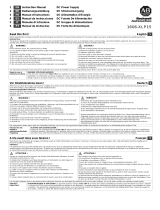 Rockwell Automation 1606-xlp15 Manuale utente
Rockwell Automation 1606-xlp15 Manuale utente
-
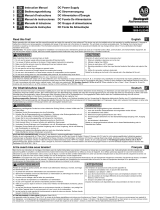 Rockwell Automation 1606-XLS240 Manuale utente
Rockwell Automation 1606-XLS240 Manuale utente
-
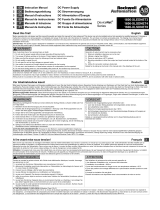 Rockwell Automation 1606-XLEDNET3 Manuale utente
Rockwell Automation 1606-XLEDNET3 Manuale utente
-
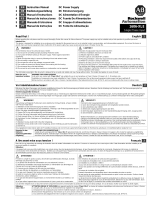 Rockwell Automation 1606-XLE Manuale utente
Rockwell Automation 1606-XLE Manuale utente
-
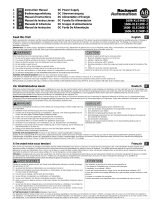 Rockwell Automation 1606-XLE240F-3 Manuale utente
Rockwell Automation 1606-XLE240F-3 Manuale utente
-
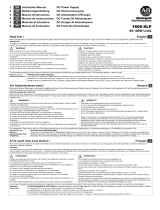 Rockwell Automation 1606-xlp Manuale utente
Rockwell Automation 1606-xlp Manuale utente
-
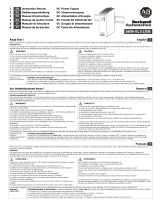 Rockwell Automation 1606-XLS120E Manuale utente
Rockwell Automation 1606-XLS120E Manuale utente
-
Rockwell Automation 1606-XLSRED Manuale utente
Altri documenti
-
BEL LEC240 Guida d'installazione
-
BEL LEC120 Guida d'installazione
-
Redlion MiniLine PSDR030W Manuale utente
-
Puls FPS300.241-002-101 Stand Alone Power Supply Manuale utente
-
Pepperl+Fuchs PS1000-A6-12.16 Manuale utente
-
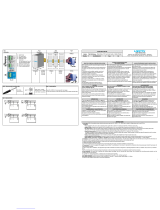 nextys NCU120 series Manuale utente
nextys NCU120 series Manuale utente
-
Puls FPS300.245-047-103 Power Supply Units Manuale utente
-
Pepperl+Fuchs PS1000-A6-24.20 Manuale utente
-
Pepperl+Fuchs PS1000-D2-24.10 Manuale utente
-
Puls QS10.DNET Manuale utente











